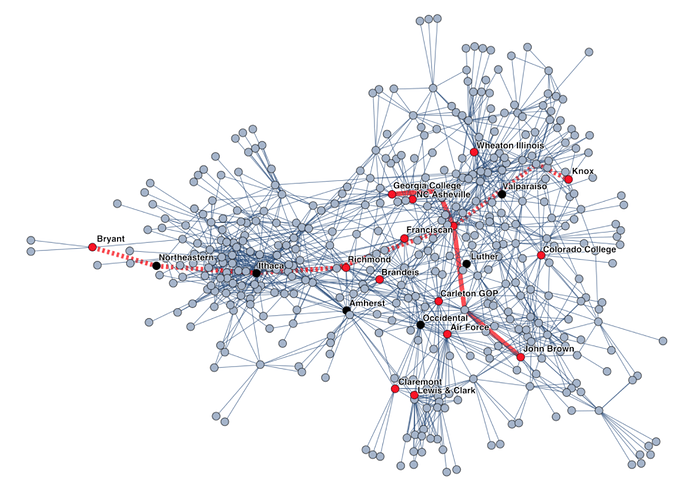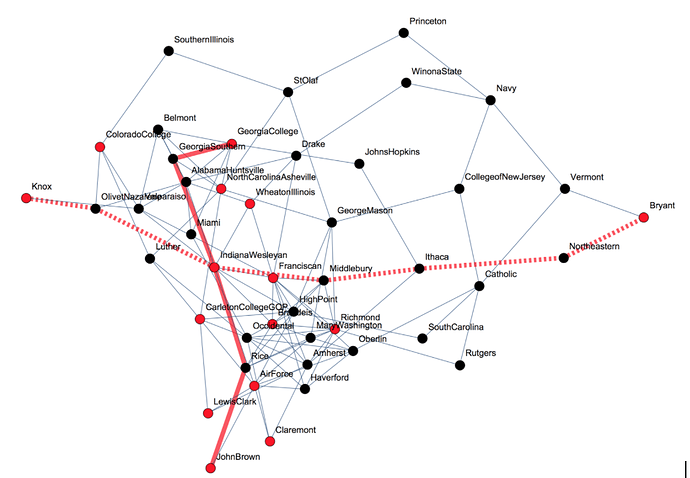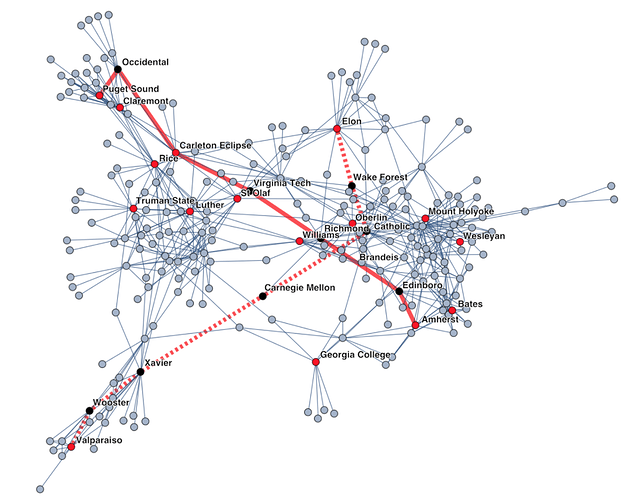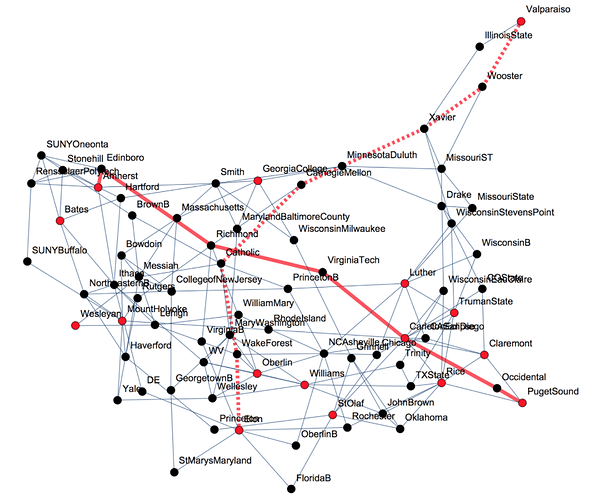This article was written by Hill Balliet and Bridget Pranzatelli, players for Claremont and the TDs of DIII Warmup.
Among top DIII teams, there is a widespread belief that the bid allocation to Nationals fails to adequately represent the division’s talent. That is not too far from the truth.
For teams who fall just short of earning a strength bid to DIII Nationals, it can be easy to look at the lack of connectivity between regions and decide that the USA Ultimate algorithm could not possibly have been fully accurate. Since DIII teams rarely travel to out-of-region tournaments, the sample size of games played across regions in a given season is significantly smaller than that of Division I, where the top teams in the country will play each other multiple times each season. The resulting lack of connectivity between regions in DIII often skews the final rankings.
Not only does internal legitimacy suffer from skepticism in the bid allocation process, but external legitimacy, or how seriously DIII is taken by the ultimate community at large, suffers due to a lack of interest and media coverage. Increasing the frequency with which DIII teams travel to play out of region games would combat both of these issues by increasing connectivity thereby improving the bid allocation process and generating more newsworthy content in the division.
The graph below illustrates the connectivity issues faced by DIII, and hints at the value that teams traveling to out of region tournaments could bring to the division.
[caption id=“attachment_49713” align=“aligncenter” width=“1068”]
Figure 1: Chart of all 2016 DIII Men’s teams and the D-I teams they played.[/caption]In Figure 1, the red dots represent teams that went to Nationals, and the lines between dots mean that the two dots on either end played each other at some point in the season before bids were allocated. ((Connecticut College is not pictured because they did not have any sanctioned games listed on http://play.usaultimate.org that occurred before bids were allocated.))
The physical distance between dots in the image roughly corresponds to how many games you must traverse to get from one to another, and the shortest path across edges to get from one team to another represents the series of games that most significantly affect the two teams’ relative rankings.
The graph below excludes teams that are not relevant to the shortest paths between Nationals-attending teams and shows more clearly how these teams were connected when the bid allocations were announced.
[caption id=“attachment_49715” align=“aligncenter” width=“1150”]
Figure 2: Graph of shortest paths between each of the men’s teams that attended DIII Nationals.[/caption]Corresponding graphs for the women’s division are in the Appendix.
The two Nationals teams that are the farthest apart on the graph are Bryant and Colorado College, who are separated by six games as shown with the red dotted line in the figures. The distance between two teams is important because the farther apart they are, the more likely that their relative rankings are wrong. For instance, if each game in the path that separates them has a 20% chance that the less talented team will upset the more talented team, then there is a 74% chance that the link between Bryant and Knox, which determines their rankings compared to each other, contains an upset ((The number of upsets is measured by a binomial random variable on 6 trials with probability 0.2. Therefore the probability that zero games were upsets was (6 choose 0)*(1-0.2)^6 or 0.26, so the probability at least one upset occurred was 74%. Similar calculations were used to compute the probability of an upset linking John Brown and Georgia College.)).
While the distance between Bryant and Knox on the graph is an outlier because Bryant only played four games before the series, large degrees of separation are quite common. Even among teams that are relatively well connected to the rest of the graph, like John Brown and Georgia College, there can be upwards of four games separating them as shown by the solid red line. The probability that an upset links John Brown and Georgia College is 59%, which means that their rankings are more likely to be wrong than not. If top teams in each region are all this likely to be linked by upsets, the bid allocations will almost certainly not be representative of the true distribution of talent in the country.
Increasing the connectivity will increase transparency and accuracy in the rankings, thereby improving the bid allocation process and increasing the validity and level of competition at Nationals. By better ensuring that the top sixteen teams are represented at Nationals, rather than sixteen of the top thirty teams, DIII teams can make their championship tournament and, by extension, their division more legitimate.
Teams can also build legitimacy in the eyes of the broader ultimate community by traveling to play out-of-region games because top teams playing each other more often will generate more high quality media content in the form of tournament previews, recaps, and film (where applicable). If top teams compete more frequently throughout the season building up to Nationals (as in D-I), they build a storyline that people in and out of the division can follow. This makes everyone more interested and invested in the outcomes; if nobody knows what to expect from teams, there is no such thing as an upset or a rivalry, and games are not as interesting to follow. The increase in newsworthy content makes the sport more exciting and legitimate for both DIII players and the wider ultimate community.
Unfortunately, traveling to play out-of-region games is not a simple task for many teams in DIII since most receive little support or subsidy from their administrations. Because of this, traveling long distances can seem financially prohibitive for many. There are, however, measures that teams can take to mitigate the costs of traveling to tournaments. Group prices on travel and lodging can provide much needed relief, and fundraising can take a huge dent out of the cost of traveling to tournaments. Five recently published an article about fundraising that not only gives suggestions for how to fundraise, but also discusses how to leverage alumni networks to make those fundraisers more effective.
If you are a player on a DIII team, and you can relate to the frustration of feeling that your tier of ultimate is discounted by the wider community, take it upon yourself to address the problems that lead to that view. It is well worth your time to invest in seeking out top teams and contributing to legitimate competition within the league.
If you want to get a jump on that goal, even while much of the country is still covered in snow, check out DIII Warmup in southern California. The tournament features lined fields, observers, and Nationals-caliber teams in both the Men’s and Women’s division, all in the warm SoCal sun. Contact [email protected] to get more information and to make sure you are kept up to date on bid deadlines.
Appendix: Women's Division Charts
[caption id="attachment_49717" align="aligncenter" width="1174"] Figure 1A: Graph of all DIII women’s teams plus the D-I teams they played[/caption]Connectivity in the Women’s Division is even worse than in the Men’s Division. Where it took 45 teams to connect the top sixteen in the men’s division, it took 75 to connect the those teams in the Women’s Division.
[caption id=“attachment_49718” align=“aligncenter” width=“1166”]
Figure 2A: Graph of shortest paths between each of the women’s teams that attended DIII Nationals.[/caption]Above, the shortest paths between Puget Sound and Amherst as well as Elon and Valparaiso have been highlighted. Both pairs are separated by six games, so as with Bryant and Knox in the Men’s Division, if each game in the path that separates them has a 20% chance that the less talented team will upset the more talented team, then there is a 74% chance that the link contains an upset.
Originally published at: https://ultiworld.com/2016/12/01/paving-better-road-diii-nationals/




